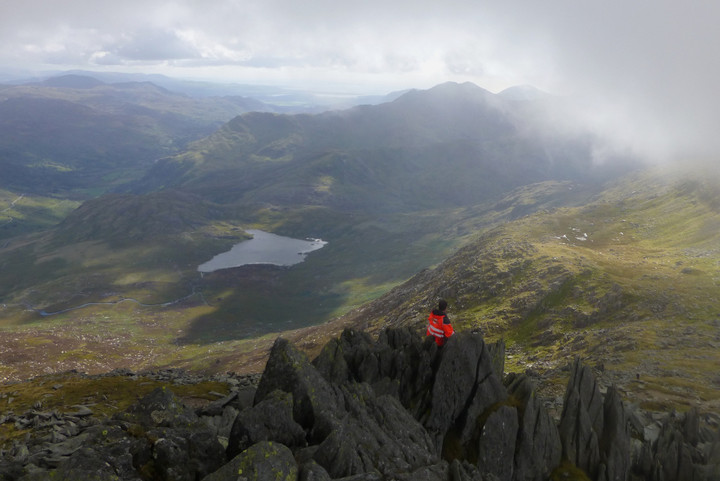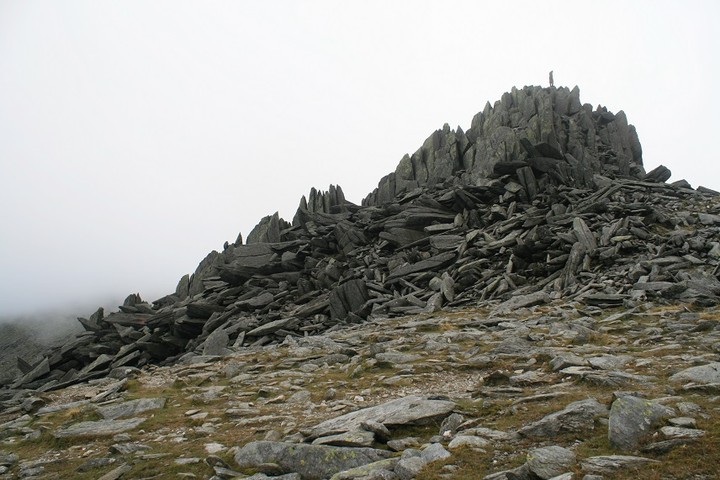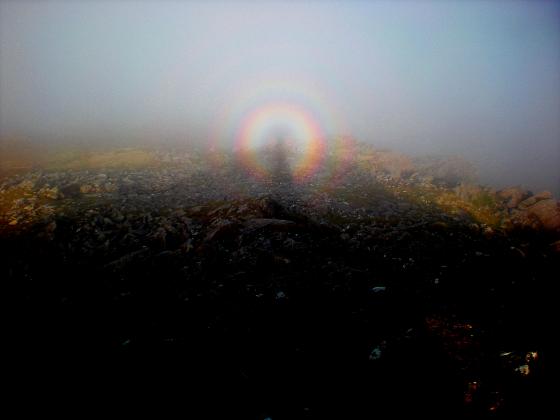
Castell y Gwynt can be seen as a prominent point on the shoulder of Glyder Fach, left of centre. For me this is probably the best side to view the Glyders from, showcasing the rugged rocky terrain and the plunging valleys and cwms beneath the peaks.

Castell y Gwynt can be seen as a prominent point on the shoulder of Glyder Fach, left of centre. For me this is probably the best side to view the Glyders from, showcasing the rugged rocky terrain and the plunging valleys and cwms beneath the peaks.

The north face of Castell y Gwynt is a mass of shattered rock forming vertiginous cliffs.

Postie takes in the view from the rock stacks of Castell y Gwynt.

Towards a missing Yr Wyddfa.

Amongst the spires.

Looking down on Dyffryn Mymbyr stone circle from Castell y Gwynt.

Through the mist Castell y Gwynt presents itself, practically blocking the ridge between Glyders.

Things become clearer, the “natural rock feature” gets bigger.

Then we see just how big this proto temple is. A perfect stranger provides some heroic scale.

Sharp and massive spires silhouette against a bright but misty Snowdon.

Looking through the spires of this cathedral of rock towards Llyn Cwmffynnon the lake is beside a stone circle

Castell y Gwynt , you shall not pass.
Unless you reeeally want too.

A truly amazing place.

Castell y Gwynt seen across Llyn Llydaw from Y Lliwedd.

The proto-temple of Castell y Gwynt hides behind the bulk of Glyder Fach, left of centre. But the Bristly Ridge route up to the site can be seen, rather terrifyingly, to the left of the shot. There are other ways up...

A little tribute to Mr Cope.... the enigmatic rocky tor is fleetingly visible through a ‘Crack in the Clouds’, top right. Hut circles are (apparently) to be found upon the near shore of Llyn Ogwen and the lower slopes of Braich y Ddeugwm.

I guess the position of Castell Y Gwynt needs no further comment, standing between Glyder Fach (left) and Fawr.... looking across Ogwen from Pen Yr Oleu Wen, Y Carneddau. Tryfan presents its western facade

The striking rocky tor of Castell y Gwynt... the ‘Castle of the Winds’... looking from Glyder Fach to Glyder Fawr. Why erect your own monument when Nature has provided this?
As we approached the peak of Glyder Fach the low clouds drifted in and we completely lost any distant views, so we concentrated on what was there. The cantilever, the stone that hangs over the edge of other stones, was smaller than I thought it was, but I still clambered round and under and on top of it, I was very nervy, among the giant boulders are deep and nasty crevices. The very very peak of the mountain is only a stones throw away. Massive and pointy boulders make up the summit, perfect for clambering all over, so long as you don’t look down the pits and holes, they are very deep in places. Two or three boulders occupy the very top and they are worn smooth by the tonnes of eager feet that just have to get to the utmost top and all the tired and weary bums, like mine.
Now and then, fleetingly, a large formless shape would half materialise through the low clouds, like it wasn’t really there at all, if no one can see it is it still there? it could only be one thing, Castell y Gwynt, we made off through the pea soup towards it.
Soon the shape in the cloud started to take on a definite form, it became rooted in this reality, and showed itself to be a, well, a natural feature ? Rocky outcrop ? a rock stack ? none of these are enough, but they are all right. From the north east monstrous spires of rock jut mostly straight up, we can see someone standing on top, striking a manly pose and showing us that you can get to the top. But you have to go round the side a bit to find a less dangerous way up, and as you get in among the castell it gets bigger and taller. Alken has to get to the top, i’m only a few meters beneath him but I decide here is enough for me, my legs are shaking so I take a precipitous seat and have a very satisfying smoke.
Far beneath me I can see llyn Cwmffynnon, and I think I can even pin point the location of the stone circle there too, far away to the south west, but close enough for the Hulk to jump to, is Yr Wyddfa, the big one, Snowdon, and it’s nearby neighbours, afternoon sunlight bathes there lower reaches but with their heads in the clouds they remain aloof, for now.
We realise with downplayed concern that time has gotten away from us, so we start the scramble down off the Cathedral of rock, this giants castle in the sky has me very much taken with it. We keep on turning back to take one last look before we yomp our way up to cloud wreathed Glyder Fawr, and it’s from here, south west of the Castell that the full size of it all is revealed, it’s so much more than a castle, it is just huge, almost completely blocking the ridge between Glyders. Its as big as a small town. I couldn’t help feeling that there are no cairns here because this was the abode of the gods, you could come up here and do the things that the ancients do (Vague?) but you couldn’t stay.
This is a very important site in understanding Bronze age Snowdonia.
The summit of Glyder Fawr is less rocky than its twin across the way, but it’s higher and similarly cloud make it devoid of any views. We don’t linger long, instead we bid a very fond farewell to Y Glyderau and head for the path that leads down to the Devils kitchen, but just before we go we are rewarded with the view of the top of Snowdon and friends, from here they look very high and very formidable, more high ridges than you can shake a walking stick at, I will need to work my way up to them.
The path soon veers off to the right, and then plunges off the edge of a cliff and into the lovely Cwm Idwal. The path is a real tour de force, a masterpiece of path making, imagine the stairway at the back door into Mordor, it was impossibly steep at times, often the path is not detectable for more than ten feet, where is it going next ? Punctuated with waterfalls, and with a full on view of Pen Yr Ole Wen and with the ever present, never out of view for long Tryfan, this was an epic footpath, The Devils kitchen, brilliant.
Unlike the great, domed summits and whaleback ridges of Y Carneddau, rising across the Ogwen Valley to the north, the chaotic, rocky heights of Y Glyderau are – to my knowledge – bereft of Bronze Age monuments. More’s the pity. Perhaps Bronze Age man did, indeed, bury his dead here, the remnants of cairn now unrecognisable, scattered within boulder fields created by the inexorable action of permafrost? Perhaps, but I think not... for what it’s worth, I reckon Nature had endowed these summits with striking monuments of her own so enigmatic that our forebears simply decided not to meddle with the status quo. Proto-temples....
First amongst these natural ‘monuments’ is surely Tryfan itself, the ‘three-peaked’ dragon back crowned by two perfect monoliths, to all the world placed by supernatural forces... OK, at least ‘super natural’. However there is another rock feature which is arguably even more striking, the prosaically named Castell y Gwynt.... ‘Castle of the Winds’. Rising between the main summits of Glyder Fach and Glyder Fawr at 3,189ft (972m) this brutal, incredible tor of shattered rock formations seems to embody the very ‘essence’, the true spirit of whatever metaphysically-induced emotions us humans experience when upon the high places... a potent cocktail of fear, awe, wonder, elation, alacrity, fatigue... and a myriad others.
Thomas Pennant wrote in 1781: “Numerous groupes (sic) of stones are placed almost erect, sharp-pointed in sheafs: all are weather-beaten, time eaten and honey-combed, and of a venerable grey-colour. The elements seem to have warred against this mountain: rains have washed, lightnings torn, the very earth deserted it, and the winds have made it the constant object of their fury”.
The ‘battlements’ of Castell y Gwynt have withstood the assault to date – although the siege will, of course, be decided in favour of the inclemental elements one day – and stand overlooking a small stone circle set, half submerged, beside the shoreline of Llyn Cwmffynnon to the approx south. There are other monuments upon the floor of Dyffryn Mymbyr and gracing the surrounding hills beyond, not least a Bronze Age cairn upon Moel Siabod. It may therefore seem odd that Y Glyderau possesses such paucity. However I am inclined to think that was the whole point, the complete absence too obvious, intentional.... that this was, indeed, considered the realm of the gods.









































































































































































































